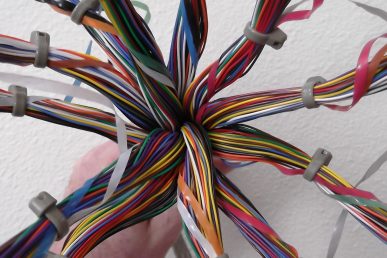SAN FRANCISCO —- Some day soon, when you assemble a piece of Ikea furniture without tears you’ll have edge computing to thank.
That’s the vision of Mahadev Satyanarayanan, known as Satya, a computer science faculty member at Carnegie Mellon University. While the word “disruptive” gets passed around more than bitcoin in the Bay Area, he means it, expecting that edge computing will touch everything from troubleshooting equipment repair to helping people with Alzheimer’s live at home for longer.
Some great (and entertaining) use cases for #edge computing at the #OpenDev keynote by M. Satyanarayanan pic.twitter.com/zs7c6qFgaR
— Lisa-Marie Namphy? (@SWDevAngel) September 7, 2017
With a halo of greying curls and wry sense of humor, Satya is considered the godfather of edge computing for his 2009 paper “The Case for VM-based Cloudlets in Mobile Computing.” He showed a demo to the 200-or so technical folks assembled for OpenDev where a researcher put together an Ikea lamp with the computer-assisted technology in the form of Google Glass. The headset showed the user a video of the assembly as he was putting it together, promptly rewarded him with “good job” when he got it right and caught him when he forgot a piece.

“We have some distance to go before these are things we can count on, but edge is coming and it will disrupt,” he concluded.
It was an inspiring kick-off to the event held at DogPatch Studios. Sponsored by the Ericsson, Intel and the OpenStack Foundation, OpenDev was devised as more of a workshop than a traditional conference. The roughly two-hour keynotes featured talks from AT&T, eBay, Verizon and Intel. (Superuser will have more on those with the videos, stat.)
The first day featured sessions more like working groups based on key topics including “Thin Control Plane,” “Deployment considerations” and “Zero-Touch Provisioning.” On day two, the afternoon slots are set aside for unworking sessions, where participants will gather insights from previous work and discuss how to move forward. (Stay tuned to Superuser for those takeaways.)
OpenStack Foundation executive director Jonathan Bryce likes to back up his predictions with numbers. And while the numbers surrounding the edge computing can be a little fuzzy (will there be 10 or 50 billion devices connected to the internet in 2020?) the crystal ball gazers have one thing right: the “estimates may be off, but the point is that all those devices will be generating data and generating work that needs to be analyzed and put into a system.”
Experiencing some seriously powerful brainstorming at the #OpenDev edge computing conference working sessions. Competitors collaborating.
— Dan Sneddon (@dxs) September 7, 2017
Bryce outlined some important goals for the event:
- Build relationships between practitioners working on edge and developers building infrastructure
- Create and publish documentation
- Develop use cases, architecture and deployment patterns
- Build best practices around management, operations, security, etc
- Devise triage needs for open projects
The outcome will be to “arrive at a vision for what this can be and where this is going to go.” More to come!
Cover Photo // CC BY NC
- OpenStack Homebrew Club: Meet the sausage cloud - July 31, 2019
- Building a virtuous circle with open infrastructure: Inclusive, global, adaptable - July 30, 2019
- Using Istio’s Mixer for network request caching: What’s next - July 22, 2019

)










